Warsaw Metro
The Warsaw Metro (Polish: Metro Warszawskie) is a rapid transit system serving the city of Warsaw, the capital of Poland. It currently consists of two lines, the north–south Line M1 that links central Warsaw with its densely populated northern and southern districts, and the central segment of the east–west Line M2. A third line (M3) is planned.
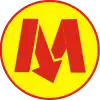 | ||||||||
 81 Series train at Plac Wilsona | ||||||||
| Overview | ||||||||
|---|---|---|---|---|---|---|---|---|
| Native name | Metro Warszawskie | |||||||
| Owner | City of Warsaw | |||||||
| Locale | Warsaw, Poland | |||||||
| Transit type | Rapid transit | |||||||
| Number of lines | 2 | |||||||
| Number of stations | 34 (8 under construction or approved) | |||||||
| Daily ridership | 568,000 (2012, avg. weekday)[1] | |||||||
| Annual ridership | 171.26 million (2015)[2] | |||||||
| Website | Metro Warszawskie | |||||||
| Operation | ||||||||
| Began operation | 7 April 1995 | |||||||
| Operator(s) | Metro Warszawskie | |||||||
| Technical | ||||||||
| System length | 35.5 km (22.1 mi)[2] | |||||||
| Track gauge | 1,435 mm (4 ft 8 1⁄2 in) (standard gauge) | |||||||
| ||||||||
The first section was opened in 1995 and gradually extended until it reached its full length in October 2008. There are additional plans to construct two more stations on this north–south line omitted during initial construction due to costs. The contract for the construction of the initial central section of the second line,[3] running east–west, was signed on 28 October 2009 and construction began on 16 August 2010.[4] The initial segment of Line M2 was opened on 8 March 2015.[5][6] This section is 6.3 kilometres (3.9 miles) long (including a tunnel under the Vistula river) with seven stations,[2] one of which (Świętokrzyska) includes a transfer between the two lines. The line is currently being expanded.[7]
In 2009, the Warsaw Metro won two "Metro Award" prizes in the categories of "Special Merit Award for Commitment to the Environment" and "Best Maintenance Programme". These were followed by the Most Improved Metro award in 2011.[8] The system consistently receives very high ratings among its passengers; a survey conducted in September 2014 indicated that 98% of the respondents rated it good or very good.[9]
History
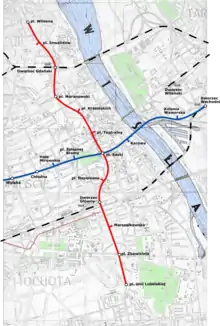
Plans to build an underground rail system in Warsaw date as far back as 1918, when the idea was first floated after Warsaw regained its status as Poland's capital city. An underground railway system was expected to solve the transport difficulties of the densely built city centre. Proper preliminary planning and boring work were initiated by the Warsaw Tramway Authority in 1925, with construction expected to start in the late 1920s. The Great Depression buried those plans as Poland and the world was gripped by economic hardship.
In 1934, with the election of a new mayor of Warsaw, Stefan Starzyński, work was to resume on the metro. The mayor dusted off the plans from the mid-1920s, and with some minor adjustments, construction of the metro was planned to start by the late 1930s, with a projected finishing date of the first of two projected lines scheduled for the mid-1940s. By then, the subway network was to consist of two lines. Line 1 (north–south line, 7.4 km or 4.6 mi long) was to follow a route similar to the present-day line and was to link the southernmost borough of Mokotów with the city centre and the northern borough of Żoliborz. This line was to be connected with the newly constructed Warszawa Główna railway station and the railway tunnel crossing the city from west to the east. Line 2 (east-west, 6.36 km or 3.95 mi long) was to start beneath the westernmost borough of Wola, proceed along the Chłodna street to the pivotal station beneath the Saxon Square and then further eastwards to the Vistula river escarpment. There, the line was to go overground, cross the river through a newly built bridge and proceed to the easternmost railway station of Warszawa Wschodnia. Altogether, in 35 years, 7 lines were to be built. The works finally started in 1938, but World War II brought an end to the ambitious undertaking. The short trace tunnels made in 1938 serve as a wine cellar today.
The city suffered heavily during World War II. Although the majority of pre-war projects perished during the war, most of the engineers behind their creation survived and returned to their city to take part in its rebirth. However, the new Communist authorities of Poland envisioned a city completely different from what it had been before the war. As the "ideal" communist city, Warsaw was to be decentralized and the need to commute to the city centre reduced. Thus, the Office for the Reconstruction of Warsaw (BOS) commissioned a number of engineers to prepare a project of a fast urban railway (SKM) crossing the city in a deep cutting. Although to a large extent it was to follow the line 1 of the pre-war plans, only the central stations were to be located underground. However, by the end of the decade, the project was cancelled. Instead, in 1948 communist planners developed a different concept with the new SKM morphing into a rapid transit line at a depth of up to 15 metres (49 feet). The suggested north–south direction, with three parallel branches of the same line in the city centre, corresponded to the planned development of the city along the Vistula. The works, however, never started and this project was also abandoned.
In the 1950s, as the Cold War raged on, Soviet strategic plans required that a secure transport link across the river Vistula be built. One of the ways to achieve this was to create a deep metro system in Warsaw (up to 46 m (150 ft) beneath the ground), which would be interlinked with the rail network and could serve as an underground conduit for transporting troops. Plans assumed that the first line (about 11 km or 7 mi long) would lie along a north–south axis, with a branch of the same line crossing the Vistula river in the city centre. The construction works started almost simultaneously at 17 different points on both sides of the river. By 1953 only 771 m (843 yd) of tunnels had been built; after the death of Joseph Stalin and the start of a period of détente, all work was halted under the pretext of technical difficulties. In the following years, only one junction tunnel and one shield-driven tunnel were continued. These works were undertaken experimentally, in order to discover the best driving methods suitable for the ground conditions beneath Warsaw (pliocene clay formations layer spread beneath quaternary soils). Finally, in 1957, all work was halted.
Since 1955, planners returned to the old idea of a shallow metro network. However, the planning phase proceeded at a very slow pace and the economic situation prevented all successive governments from actually starting serious work. Finally, in 1984, the program was approved by the government and the first tunnels built. Lack of funds, technical difficulties, shortage of materials and outdated tunnelling methods meant that the work progressed very slowly, sometimes at a speed no greater than 2 m (6 ft 7 in) per day.
The Metro was opened on 7 April 1995 with a total of 11 stations. The initial line, Line M1, has 21 stations over a route distance of 22.7 km (14.1 mi).
The station names on the M1 line are announced by Ksawery Jasieński.
Timeline
| Segment | Line | Length (km) | Date opened |
|---|---|---|---|
| Kabaty – Politechnika | M1 | 11.1 | 7 April 1995 |
| Politechnika – Centrum | 1.4 | 26 May 1998 | |
| Centrum – Ratusz Arsenał | 1.7 | 11 May 2001 | |
| Ratusz Arsenał – Dworzec Gdański | 1.5 | 20 December 2003 | |
| Dworzec Gdański – Plac Wilsona | 1.5 | 8 April 2005 | |
| Plac Wilsona – Marymont | 0.9 | 29 December 2006 | |
| Marymont – Słodowiec | 1.0 | 23 April 2008 | |
| Słodowiec – Młociny | 2.6 | 25 October 2008[10] | |
| Rondo Daszyńskiego – Dworzec Wileński | M2 | 6.3[2] | 8 March 2015[5] |
| Dworzec Wileński – Trocka | 3.1 | 15 September 2019[11] | |
| Rondo Daszyńskiego – Księcia Janusza | 3.4 | 4 April 2020[12] | |
| Total: 34 Stations | 35.5 km[2] |
Lines
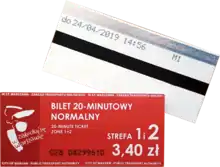
| # | Opened | Length | Stations |
|---|---|---|---|
| M1 | 1995-2008 | 22.7 km (14.1 mi)[2] | 21, 23 planned in total[2] |
| M2 | 2015 | 12.8 km (8.0 mi), 32 km (20 mi) planned in total[2] | 13, 21 planned in total[2] |
| M3 | In planning | 8 | |
| Total: | 35.5 km (22.1 mi) | 58 |
Rolling stock
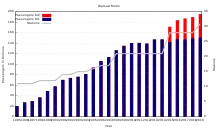
| Line | Current stock | Image | Introduced | Driving | Cars per set | Sets | Length (m/ft) | Seats | Capacity |
|---|---|---|---|---|---|---|---|---|---|
| M1 | Metrovagonmash (81-717.3/714.3) |
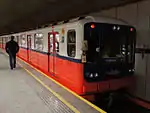 |
1990, 2006 | OPO | 6 | 15 | 115.4/379 | 260 | 1200 |
| M1 | Metrovagonmash (81-572/573) |
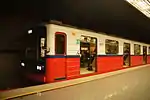 |
1994-1997 | OPO | 6 | 115.4/379 | 260 | 1200 | |
| M1 | Metrovagonmash (81-572.2/573.2) |
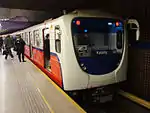 |
2009 | OPO | 6 | 7 | 115.4/379 | 260 | 1200 |
| M1 | Alstom (Alstom Metropolis) |
 |
2000–2005 | OPO | 6 | 18 | 117.1/384 | 264 | 1454 |
| M1 | Siemens Mobility (Siemens Inspiro) |
.jpg.webp) |
2013 | OPO | 6 | 35 | 117.7/386 | 232 | 1500 |
| M2 | |||||||||
| OPO: One Person Operation. | |||||||||
Initially, all of the trains were Russian built. They first arrived in Warsaw in 1990 as a "gift" from the USSR, five years prior to the Metros opening, from the Metrovagonmash plant in Mytishchi near Moscow (model 81-717.3/714.3 - 10 carriages). Subsequent trains arrived from Saint Petersburgs Yegorov Plant in 1994 (81-572/573 - 32 carriages) and additional 18 81-572.1/573.1 carriages in 1997.[13]
In 1998, 108 new carriages were ordered from French Alstom. These were all delivered by 2005[14] (24 were produced in Barcelona and the remainder in Chorzów).[15] In 2006, additional carriages were ordered from Russia, with deliveries taking place up to 2007.
In February 2011, an order was signed with German Siemens for 35 complete trains from their new Inspiro line. A large number of these were to be manufactured in Poland by Newag. The first 5 of these trains were put into service in 2013. However, in November 2013 a fire broke out in one of the carriages and for safety reasons all five were withdrawn from operation until the cause of the fire was determined. Once the investigation was completed the five new Inspiro trains were placed back into service in March 2014.
As of 2020, the majority of the operating rolling stock is Siemens-built (Siemens Inspiro type).
.jpg.webp)
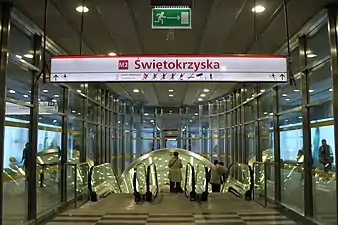 Świętokrzyska Station, M2
Świętokrzyska Station, M2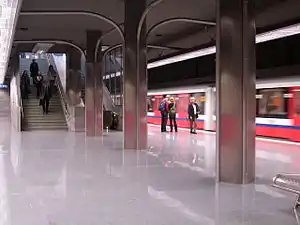
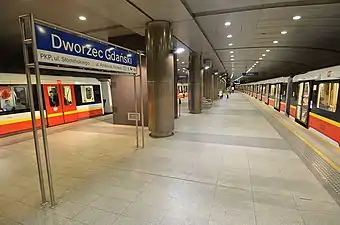
Depots
A single depot is located south of the Kabaty station. There is a single-track connection between the depot and Warszawa-Okęcie station on the PKP rail network. This link is not electrified, and used only for an occasional rolling-stock transfer.
Plans
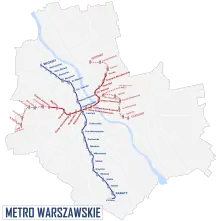

The first line was a compromise between earlier route proposals further east and west (one of which belonged to the planned Line 4) and as such does not go to some important areas of the city. For example, it does not pass directly under the old town, Warsaws main tourist attraction, which has few public transport links, passing it about 600 metres (2,000 feet) to the west. It also does not directly connect to the central railway station, with the nearest stop being over 400 metres (1,300 feet) to the east (the second line also avoids it, with the closest station about 400 metres (1,300 feet) to the north). Until the opening of the second line in March 2015, the Metro system was confined to the western bank of the Vistula river, thus doing nothing to ease traffic problems on Warsaws bridges, a major bottleneck between the city center and the eastern Praga district. Plans for the third line to Warsaw Chopin Airport have been abandoned for the foreseeable future, with the airport served by a new railway station instead.
Transport planners have suggested that the WKD, a light rail line that runs to the western suburbs, could be integrated with the city's tram system, or be more closely tied to the Metro and a future suburban rail network, or both. The first such plans were prepared in the late 1930s and the railway tunnel running below the city centre was to be shared by both the railways and the metro. In the mid-1990s the WKD, PKP and Warsaw Metro systems were temporarily integrated and Warsaw city travel cards were valid also in the suburban railways. This idea was, however, dropped in 1999 due to financial problems.
Recently completed extensions
On 11 March 2016, a 1 billion zł (€225 million) contract was awarded to the Italian company Astaldi to build the first phase of the North-East second subway line extension with 3.2 kilometres (2.0 mi) of track and 3 stations: Szwedzka, Targówek and Trocka. On 30 April construction on Szwedzka station started, and on 2 May the other two stations started construction. Construction of this phase took 3 years and opened on 15 September 2019. Initially, this extension was to be built at the same time as the west extension which is due to be completed in 2020. However, due to delays, it was decided that each extension will be built at its own pace.
Future extensions
- Plac Konstytucji and Muranów, two stations omitted from the original plan to reduce cost were to be built by 2009, but construction has not yet started, and will not start in the near future.[16]
- Line M2: the first, central section[17] now consists of thirteen stations: Księcia Janusza, Młynów, Płocka, Rondo Daszyńskiego, Rondo ONZ, Świętokrzyska, Nowy Świat, Centrum Nauki Kopernik, Stadion Narodowy, Dworzec Wileński, Szwedzka, Targówek Mieszkaniowy and Trocka. It passes under the Vistula river between the Centrum Nauki Kopernik and Stadion Narodowy stations. Most of the funding for building this section was secured from the European Union and construction started in August 2010. The original plan to finish this section in time for Euro 2012 was too optimistic, with final completion occurring in March 2015. This line was built using a different boring technology that allowed for much faster construction compared to the first. The rest of Line M2 and its branches, totaling 28 stations, will be built in the future. A tender was opened for 35 trains (most to be used on Line M2, some on Line M1); Škoda Transportation and Metrovagonmash submitted the lowest price[18] but Siemens/Newag scored more points and were chosen to provide the trains.[19]
- The final Warsaw Metro plan calls for four lines incorporating 100 km (62 mi) of track.[20]
Network map
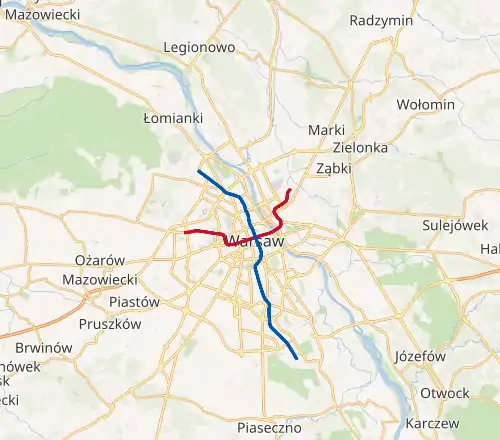
References
- Inline citations
- "Raport roczny 2012" [Annual Report 2012] (PDF) (in Polish and English). 2012. p. 6 (12+13) (i.e. str.6 (12+13)). Retrieved 2015-03-08.
- "Raport roczny 2015" [Annual Report 2015] (PDF) (in Polish and English). 2016. p. 9. Retrieved 2017-01-04.
- website of Warsaw Metro - Line 2 information and maps
- PAP. "Wielka chwila: ruszają prace przy drugiej linii metra" (in Polish). Gazeta.pl. Retrieved 2010-08-13.
- "Warsaws second metro line opens". Radio Poland. March 8, 2015. Retrieved 2015-03-09.
- "Crowds take first ride on Warsaws new subway line". U-T San Diego. Associated Press. March 8, 2015. Retrieved 2015-03-08.
- "TLC Involved in Project to Expand Warsaw Metro System". TLC. April 25, 2019. Retrieved 2019-04-25.
- "the big idea - The Metros Awards". The Metros Awards. Retrieved 13 April 2016.
- "Pasażerowie zadowoleni z metra. Mamy wyniki najnowszych badań". Onet.pl (in Polish). August 23, 2014. Retrieved 2014-09-07.
- "First train to pull into Mlociny metro station". Radio Poland. Retrieved 2008-10-25.
- "Warszawa: Metro jeździ już na Targówek". TVP. Retrieved 2019-09-15.
- "Warszawa: Uruchamiamy wolskie stacje metra". Retrieved 2020-04-03.
- Metrowahonы (in Russian). Archived from the original on 2006-05-13.
- "Warsaw Metro". Alstom Cars. Archived from the original on 2006-10-07.
- "Przegubowiec". Tabor Metra Warszawskiego (in Polish).
- "Archived copy". Archived from the original on 2009-02-02. Retrieved 2009-02-02.CS1 maint: archived copy as title (link)
- "Archived copy". Archived from the original on 2010-09-09. Retrieved 2010-09-09.CS1 maint: archived copy as title (link)
- "Urban rail news in brief - October 2010". Railway Gazette International. October 3, 2010. Retrieved 2010-10-05.
- "Warszawa metro selects Siemens Inspiro". Railway Gazette International. October 15, 2010. Retrieved 2010-10-16.
- "Warsaw Metro". Railway Technology. Retrieved 13 April 2016.
- Bibliography
- Various authors (1962). Jan Rossman (ed.). Studia i projekty metra w Warszawie; 1928-1958. Warsaw: Arkady. p. 391.
External links
| Wikimedia Commons has media related to: |
- Official website

- Construction the second line of Warsaw Metro – official website
- Warsaw at UrbanRail.net
- Warsaw Metro Map
- Warsaw Metro fan site and discussion forum (in Polish)
- pictures of Warsaw Metro (in English and German)
- Stations as Canvas: Painting the Warsaw Metro
- Videos
- Television TVPW - The Information Movie about Warsaw Metro system (production: TVPW) (in Polish)
- Television TVPW - Relation of opening the "Słodowiec" station (production: TVPW) (in Polish)
- Television TVPW - The movie about building the metro in Warsaw from the beginning to the end (production: TVPW) (in Polish)
- Television TVPW - The interview with Robert Jaryczewski - the best metro driver of the world in 2008 (production: TVPW) (in Polish)
- Television TVPW - The movie about signaling in metro in Warsaw (production: TVPW) (in Polish)
